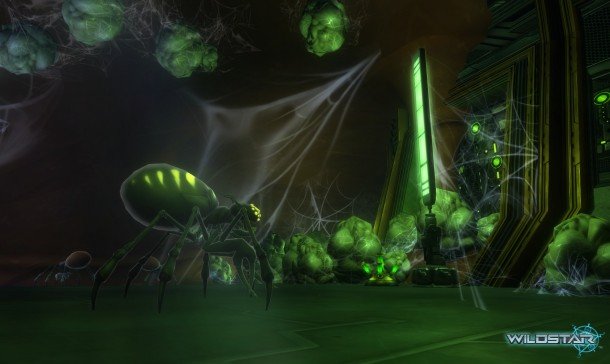WildStar preview

Carbine Studios' Jeremy Gaffney has huge expectations for the developer's upcoming game, WildStar. Though most seem to be gunning for second—or even third—place in the bloated massively-multiplayer online RPG genre, Gaffney isn't ready to settle for that. Several times during our demo of the game he made his ambitions clear: "We want to be the biggest game ever."
Though this might sound like a developer getting overzealous, Carbine has the industry clout to make it. The studio was formed by 17 former Blizzard employees, many of which worked on World of Warcraft—so it's no wonder that many of the trappings ring reminiscent of the game they helped make in 2004. It features two warring factions, a handful of colorful races, a grouping of archetypal classes, and a colorful, stylized graphical style.
Once we got past the basics, though, we began to see what makes WildStar unique. Set on the planet Nexus, a world where a conglomeration of displaced peoples called the Exiles are attempting to call home, two factions are engaged in an all-out war.

Continuing in the trend of recent MMOs, WildStar is action-packed, with real-time inputs being required to take down foes. Where it separates itself is in its abilities, all of which are executed with a visible area of effect. Whenever we hovered over an icon we saw the area where the highlighted ability would hit, letting us know exactly where we should move to in order to inflict maximum damage. That, alone, is far from groundbreaking, but WildStar doesn't only display the player's AOEs—enemies' and allies' AOE indicators are shown as well, totally changing the dynamic of traditional battles.
With one seemingly small change, things move from "playing the interface," as Gaffney described it, to actually playing the game. We were actively dodging enemy attacks, and using our indicators to return blows of our own. Already we were more engaged than we typically are in MMO combat, but Gaffney claims that the combat style really shines the more you play, making group battles—and even raids—more organic.
Instead of looking up a YouTube video of a boss, players can simply adjust based on the attacks, just as they would in a typical action game—WildStar's combat rewards reaction and teamwork instead of memorization and planning. It also allows players to come up with more interesting strategies. Since healing spells are AOEs, healers can set up healing stations of sorts, or have the tanks stand in a row as to maximize the efficiency of their mana.

Another key difference is in WildStar's "Paths." Separate from classes, players will also be tasked with choosing between Scientist, Soldier, Settler, and Explorer. Paths aren't meant to replace how we play MMOs—they're there to reward us for enjoying them the way we want to. Soldiers, for instance, will be given bonus quests to kill enemies, whereas Explorers can gain experience discovering secret passages to new areas that no other Path would be able to find. Settlers are in charge of rebuilding Nexus, and can take up social quests to buff allies by constructing camps and improving towns, rewarding players interested in role-playing or simply being social. Scientists are perfect for lore fiends, and are capable of finding out what happened to the world of Nexus.
Keep up to date with the most important stories and the best deals, as picked by the PC Gamer team.
There's plenty to discover about Nexus, too. The world is beautiful, and filled with unique locations that take advantage of the worlds' mystique as players fight to unearth the history of the strange locations. One goal Carbine Studios discussed was to make sure each zone not only looks unique, but feels that way, too. Giant blue crystals occupying one area might make it visually interesting and easier to distinguish from another zone, but it's even more alluring if said crystals create low-gravity zones. And if those low-gravity zones make for unique gameplay, and allow the Scientist to learn about the planet, and give Explorers new locations to discover, and the Settlers more people to socialize with, and the Soldiers more... well, more stuff to kill, then everyone is gaining a memorable experience.

Not every element of WildStar is wholly unique—some aspects are more iterative than innovative. Gaffney laid out the content plan for each type of gamer, explaining how the MMO will handle those interested in vastly different aspects of the genre. For the solo player, WildStar will have a progressive plot with frequent updates; for those interested in PvP the game will include a "Warplot" system to give players the ability to build their own battlefield; and those interested in traditional MMO end-game will find a suite of raids. These raids will change regularly, too, in order to give competitive groups new accolades to fight over after the "server fists" are all taken care of.
The Old Republic, Guild Wars, and Rift have all found convenient ways to sidestep actually competing with World of Warcraft in interesting ways, and it's somewhat refreshing to hear a developer admitting to, for the first time in years, attempting to build a "WoW killer." Will Carbine succeed? It's impossible to know, but with a clever mixture of new features and improvements over new ones we feel like it certainly has a shot at doing so, as well as being one of the most interesting MMORPGs currently in development. With a release window currently placing WildStar in 2013 (unless more time is needed, in which case Carbine is prepared to throw a "when it's ready" card) we won't have to wait too long to find out.

